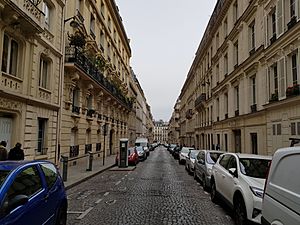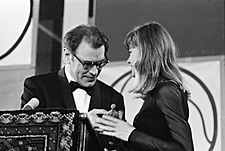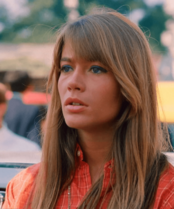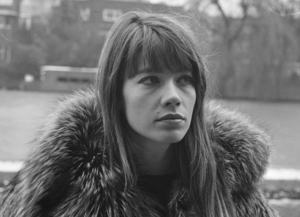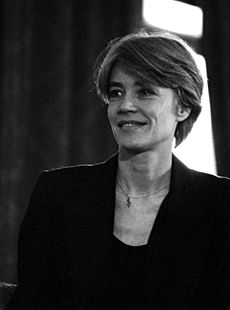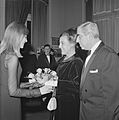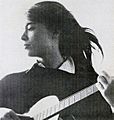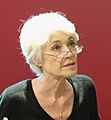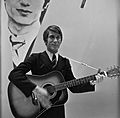Françoise Hardy facts for kids
Quick facts for kids
Françoise Hardy
|
|
|---|---|
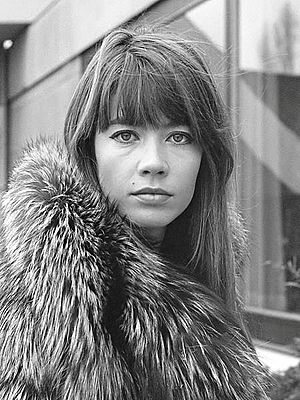
Hardy in 1969
|
|
| Born |
Françoise Madeleine Hardy
17 January 1944 Paris, France
|
| Died | 11 June 2024 (aged 80) Paris, France
|
| Occupation |
|
| Years active | 1962–2018 |
| Spouse(s) | |
| Children | Thomas Dutronc |
| Musical career | |
| Genres |
|
| Instruments |
|
| Labels |
|
| Signature | |
 |
|
Françoise Madeleine Hardy (born January 17, 1944 – died June 11, 2024) was a famous French singer, songwriter, and actress. She was best known for singing sad and emotional songs. Françoise became very popular in the early 1960s as a main star of the yé-yé music style. Yé-yé was a type of pop music popular in France, often sung by young women.
Besides singing in French, she also sang in English, Italian, and German. Her music career lasted over 50 years, and she released more than 30 studio albums.
Françoise Hardy was born and grew up in Paris, France. She started her music career in 1962 with the French record label Disques Vogue. She quickly became famous with her song "Tous les garçons et les filles". She later started recording in London in 1964. This helped her music grow and change, leading to albums like Mon amie la rose and La maison où j'ai grandi.
In the late 1960s and early 1970s, she released albums such as Comment te dire adieu and Message personnel. These albums helped her become an even more respected artist. During this time, she worked with famous songwriters like Serge Gainsbourg and Michel Berger.
From 1977 to 1988, she worked with producer Gabriel Yared on several albums. Her 1988 album Décalages was announced as her last, but she returned eight years later with Le danger. This album had a new, tougher rock sound. Her later albums in the 2000s, like Clair-obscur, brought back her softer style. In the 2010s, she released her last three albums, including Personne d'autre.
Beyond music, Françoise Hardy also acted in movies like Château en Suède and the American film Grand Prix. She became an inspiration for fashion designers such as Yves Saint Laurent and Paco Rabanne. She also worked with photographer Jean-Marie Périer.
Françoise Hardy also became an astrologer and wrote many books about it starting in the 1970s. She also wrote fiction and non-fiction books from the 2000s. Her autobiography, Le désespoir des singes... et autres bagatelles, was a very popular book in France. As a public figure, she was known for being shy and not always loving fame. This was partly because she struggled with feeling worried and unsure of herself throughout her life.
She was married to fellow French singer-songwriter Jacques Dutronc in 1981. They remained married until her death. Their only son, Thomas, is also a musician. In 2021, Françoise Hardy shared that her health had gotten worse due to cancer treatments, and she would not be able to sing again.
Françoise Hardy is one of the best-selling singers in French history. She is still seen as an important and inspiring person in French pop music and fashion. In 2006, she received a special award called the Grande médaille de la chanson française from the Académie française. This award recognized her amazing music career. Her work has been featured on many critics' lists of great music.
Contents
Early Life and Beginnings
Françoise Madeleine Hardy was born on January 17, 1944, in Paris, France, during World War II. At the time she was born, there was an air raid alert, and the clinic's windows were damaged. She believed being born during this difficult time made her feel worried a lot as an adult.
Her mother, Madeleine Hardy, raised Françoise and her younger sister Michèle as a single parent. Their father, Étienne Dillard, came from a rich family but was married to another woman. He did not help them much financially and was mostly absent from their lives. He only visited the girls a few times a year. Madeleine Hardy raised her daughters strictly in a small apartment in Paris.
Françoise had a difficult childhood. She mostly did quiet activities like reading, playing with dolls, or listening to the radio. Her father wanted the girls to go to a Catholic school called Institution La Bruyère. Françoise felt embarrassed because her family wasn't as wealthy as her classmates'. She wrote in her autobiography that this is likely where her constant feeling of shame began. Her grandmother also made her feel insecure by often telling her she wasn't pretty and was a bad person.
Between 1952 and 1960, Françoise and her sister spent every summer in Austria to learn German. This was encouraged by her mother's new boyfriend. Françoise's father played piano, so she was encouraged to take piano lessons when she was very young. However, she quickly stopped after feeling too nervous to perform on stage.
Françoise was a good student and finished high school early in 1960 at age 16. To celebrate, her father asked what gift she wanted, and she chose a guitar. She then started writing her own songs. Her mother wanted her to study at a political science school, but Françoise found it too hard. She soon left and went to the Sorbonne to study German.
Françoise used her free time to write songs on her guitar. She started performing her songs at a small club called Moka Club, or Club des mordus, every Thursday. She sang "in front of an audience of retirees." Around this time, she tried out for the record label Pathé-Marconi after seeing an ad. She was not accepted, but she was happy that she had held the directors' attention for longer than she expected. She also felt encouraged when she heard her recorded voice, which sounded better than she thought.
She then went to Philips Records, where she was told to take singing lessons. Following this advice, Françoise joined Le Petit Conservatoire de la chanson in 1961. This was a school for radio performers, and it was the first of its kind in France. It was led by singer Mireille Hartuch. The Petit Conservatoire started as a radio show in 1955 and became a popular TV show in June 1960. If a student performed well, they could release their song on the radio or even perform it on TV.
Mireille Hartuch, who was very picky, accepted Françoise right away. She said in 1966, "The first time Françoise came into the classroom to try out, I didn't know if she sang, if she played guitar, what she was doing. I just looked and felt like there was a spark, something that lit up." They became very close, almost like mother and daughter, and stayed friends for a long time.
Music Career
1961–1963: Becoming Famous
On May 14, 1961, Françoise Hardy tried out for the French record label Disques Vogue. Directors Serge Goron and Léo Vidaly suggested she take music theory and harmony lessons. Vogue sound engineer André Bernot was impressed by her looks and offered to teach her music basics to improve her rhythm. Bernot later recorded a four-song demo with her. He gave it to Jacques Wolfsohn, an important director at Vogue.
Wolfsohn was looking for a female singer to record "Oh oh chéri," a French version of Bobby Lee Trammell's song "Uh Oh." After she tried out in person, Wolfsohn immediately offered her a one-year contract, which she signed on November 14, 1961. When Mireille Hartuch learned about Françoise's record deal, she featured her student on the Petit Conservatoire TV show on February 6, 1962. This became one of the most popular French TV moments ever.
During the show, the host asked Françoise what the English words "yeah! yeah!" in her song meant. The French word "yé-yé" later became popular. Sociologist Edgar Morin used it in an article in Le Monde in 1963. He wrote about the new youth-led pop music scene. The yé-yé style became very popular thanks to the radio show Salut les copains and a successful magazine with the same name.
Vogue released Françoise's first record in May 1962. It included "Oh oh chéri" and her own songs like "Il est parti un jour" and "J'suis d'accord." It also had the emotional song "Tous les garçons et les filles". This song was put on the B-side (the less important side) of the record because the label thought it was too sad for young people. On June 5, 1962, Françoise proudly showed her record cover on the Petit Conservatoire show.
In early October, Françoise filmed a black-and-white music video for "Tous les garçons et les filles." It was shown on the TV show Toute la chanson. Françoise and the show's producer chose this song, even though Wolfsohn didn't want to promote it. Most French people saw Françoise on October 28, 1962. The video was shown during a break in the TV broadcast of the presidential election results. This made the song very popular among young people, especially teenage girls. Radio stations, like the youth-favorite Europe n° 1, played it a lot. The song became even more famous with a Scopitone music video. This video showed Françoise on an amusement ride with two girls whose skirts were lifted by the wind.
Because the song was so successful, Vogue released two more records almost at the same time. These were later put together with the first one to make her first studio album, usually known as Tous les garçons et les filles. In France, long-play records (LPs) were not very common at first. So, Françoise's early albums were collections of songs from her smaller, four-track records. Most of her full albums were released without a title, only her name on the cover. People usually called them by the name of their most popular song.
Her first studio album quickly won the Trophée de la Télévision and the important Grand Prix du Disque award from the Académie Charles Cros. She later said, "It would have made me even happier if I had received it a little later for records better made than this." On May 11, 1962, Françoise performed live for the first time with other young singers at a gala in Nancy. She also performed on Christmas Eve in Brussels and had a successful tour in Southern France from late 1962 to early 1963. By early 1963, 500,000 copies of "Tous les garçons et les filles" had been sold in France. This number grew to two and a half million in the next few months.
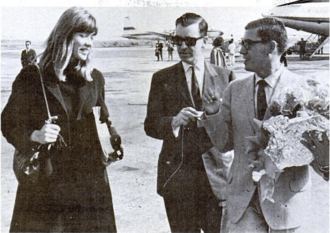
Between late 1962 and early 1963, Françoise Hardy's songs "J'suis daccord," "Le temps de l'amour," and "Tous les garçons et les filles" were at the top of the French singles chart. In January 1963, she was on the cover of Paris Match magazine in an article about "new millionaires of song." She signed a new five-year contract with Vogue and an agreement with Editions Musicales Alpha.
In February 1963, Françoise appeared on the TV show Cinq colonnes à la une with Sylvie Vartan and Sheila. They became known as the three biggest stars of the yé-yé era. On February 3, she performed for the first time at the famous Olympia concert hall in Paris. She was the opening act for Richard Anthony. From February 26 to April 10, Françoise took part in the Gala des Stars concert tour, which was very successful. During the tour, she met Michel Bourdais, a young designer who created her first portrait.
Between two tour dates, she represented Monaco at the Eurovision Song Contest 1963 in London. She sang "L'amour s'en va" and finished in fifth place. "L'amour s'en va" reached number 5 on the French charts in June 1963. In October, she released her second studio album, Le premier bonheur du jour. That month, she received the "Youth" Edison Award in the Netherlands. Author Godfried Bomans gave her the award and praised her as a "creative artist." From November 7 to December 18, 1963, Françoise again opened for Richard Anthony at the Olympia. The press, who had criticized her stiff live performances before, now praised her.
As a top yé-yé star, Françoise Hardy became very important in French music. She was the most popular French female singer outside of France. Starting in 1963, translated versions of "Tous les garçons et les filles" were sent to Italian, German, and English-speaking countries. Italy was the first foreign country where she became successful. The song became "Quelli della mia età" and sold 255,000 copies there. It was number one on the singles chart for several months.
Later that summer, she recorded new songs in Milan, Italy. These were included in the Italian album Françoise Hardy canta per voi in italiano. The song "L'età dell'amore" also topped the Italian charts. On October 11, Françoise performed in Barcelona, Spain. In November 1963, she went on her first Italian tour, visiting mostly small towns. The singer was also successful in Portugal and traveled to Lisbon in late 1963 to appear on several TV shows.
1964–1968: International Fame
During the time of the British Invasion (when British bands became very popular), Françoise Hardy wanted to update her music. She decided to leave the French studios, which she felt were not good enough, and record her songs at Pye Records' studios in London. In February 1964, she worked with producer Tony Hatch. She recorded a record that included a cover of "Catch a Falling Star" and three of her hits translated into English. On February 21, she promoted "Catch a Falling Star" on the TV show Ready Steady Go! English audiences first preferred her songs in French. "Tous les garçons et les filles" entered the UK Singles Chart on July 1, 1964.
Her 1965 English song "All Over the World" was a big hit in the United Kingdom. It reached the Top 20 and stayed on the charts for 15 weeks. It was also popular in South Africa, Australia, and New Zealand. This was probably her most famous song among English-speaking listeners. She promoted the song by performing on British TV shows like Ready Steady Go! and Top of the Pops.
In 1965, Françoise Hardy went to New York City to sign a record deal with Kapp. This allowed them to sell her records in the United States. The label released her first studio album there called The "Yeh-Yeh" Girl From Paris!. They also released the song "However Much," which was an English version of "Et même..." While in the United States, Françoise appeared on American television for the first time on NBC's show Hullabaloo. She performed "However Much," a bilingual version of Charles Trenet's "Que reste-t-il de nos amours ?" and "The Girl from Ipanema".
The singer became famous overnight in Germany after she appeared on the TV show Portrait in Musik on April 28, 1965. Soon after, the album In Deutschland was released. It had translated versions of her old songs and five new ones. Her most popular song in Germany was "Frag' den Abendwind," which stayed on the national singles chart for 24 weeks.
Her French and Italian record companies wanted her to take part in the Sanremo Music Festival 1966. She reached the finals with the song "Parlami di te."
On April 12, 1966, Françoise Hardy was one of 46 performers in a famous group photo taken by Jean-Marie Périer for Salut Les Copains. This photo became a symbol of the yé-yé era and was known in France as the "photo of the century."
Starting in late 1967, Françoise Hardy began releasing her records through her own company, Asparagus. However, Vogue still distributed them. She later said she regretted this choice. Her seventh French studio album, Ma jeunesse fout le camp..., was the first one produced by Asparagus. It was released in November 1967.
Françoise Hardy gave her last three live performances in Kinshasa, Congo, in June 1967.
An English producer suggested that Françoise record her second English-language album in the spring of 1968. This album was known by different names, including En anglais and Loving, depending on the country.
1969–1976: Becoming a Mature Artist
In the late 1960s and early 1970s, Françoise Hardy wanted to be seen as a serious artist. This meant her music might not be as popular as it was with Disques Vogue. In 1970, she left the label and signed a three-year contract with Sonopresse. She also started a new production company called Hypopotam and her own music publishing company, Kundalini. Sonopresse gave her a lot of money upfront, which allowed her to pay for her own projects. She said this was "the happiest time" because she could work on her music independently.
This change in her career began with several compilation albums in 1970. These included Françoise in France, One-Nine-Seven-Zero (recorded in English), and Träume, her last album in German.
Her first French studio album produced by Hypopotam was Soleil, released in the spring of 1970. It had many different music arrangers. In the summer of 1970, Françoise released her second-to-last Italian song, "Lungo il mare." Neither this song nor her next Italian song became successful. She also recorded in Spanish for the first time. In the spring of 1971, Françoise released the song "T'es pas poli," written by Patrick Dewaere. She was impressed by his performances and asked him to work with her. To promote the song, Dewaere and Françoise performed it on several TV shows. Despite Françoise's fame, the song did not sell as well as expected.
In the early 1970s, Françoise Hardy met Tuca, a Brazilian singer and guitarist living in Paris. They quickly became good friends. After attending a music festival in Rio de Janeiro, Françoise decided to make an album with Tuca in late 1970. This was the first time Françoise could work with a songwriter on songs before recording them. She also helped choose the string arrangements.
The album, La question, was released on October 16, 1971. It was promoted with songs like "Le martien" and "Rêve." Even though French critics loved the album when it came out, it did not sell well. It wasn't promoted much on TV and didn't get played much on the radio. However, La question has gained a special group of fans over time and is now seen as Françoise Hardy's best artistic work. She said she was proud of the album, adding in 2008 that "an ambitious record can be more or less ignored when it is released but ends up having a long life."
After La question didn't sell well, Françoise Hardy decided to try a different sound. She hired British arranger Tony Cox to produce her next album. This album was known as Et si je m'en vais avant toi, L'éclairage, or "the orange album" because of its cover. It was released in November 1972. Right after finishing this album, Françoise and Cox recorded the English album If You Listen. This album included cover versions of less-known American and British songs.
Françoise's time with Sonopresse ended with the albums La question, Et si je m'en vais avant toi, and If You Listen not selling well. She still thought these were her "best [albums] by far." When her contract ended, the record label decided not to renew it. Françoise wasn't too bothered by the low sales because she felt she had made the music she wanted to make.
Around 1972, Françoise contacted songwriter and producer Michel Berger. She wanted to work with him because she liked his work with Véronique Sanson. Berger agreed to produce her next album but couldn't write all the songs. He wrote two of the 12 songs and found the other 10, which Françoise felt were not as good. After a time of working independently, she was back to a busy schedule with a demanding producer. She later said Berger was "a man in a hurry."
The album was recorded in July 1973, soon after Françoise gave birth to her son Thomas Dutronc. Message personnel was released that year on Warner Bros. Records. Françoise signed a three-year contract with them. The album was a success with both critics and the public. Its main song was a big hit in France and helped restart her career. She promoted the album by appearing on several French TV shows.
For her next project, Françoise wrote 10 songs that told a story. She worked mainly with her friend Catherine Lara to put the words to music. The album, Entr'acte, was released in November 1974. It did not sell well. Françoise then decided to take a break from music to spend more time raising her child. She only released two songs between 1975 and 1976. The first one did not sell well. The second was "Femme parmi les femmes," the main song from a film by Claude Lelouch.
Around 1976, Michel Berger contacted Françoise again. He wanted her to sign with his new record label, Apache. She sent him some songs, but Berger wanted an album with a single theme. So, she decided not to join his label. She finally signed a three-year contract with Pathé-Marconi.
1977–1995: Working with Gabriel Yared and a Break
For her 1977 album Star, Françoise Hardy hired Gabriel Yared as a producer and arranger. This album included six songs written by Françoise, along with songs by other artists like Serge Gainsbourg and Catherine Lara. At first, their working relationship was difficult, and Star was recorded in a "strained atmosphere." Françoise was even called "ice queen." However, they later became good friends.
Star was a commercial success. It brought Françoise back into the public eye and introduced her music to a new generation. Despite their difficult start, Françoise and Yared continued to work together for almost six years and made five albums. In 1991, Françoise said about working with Yared: "Gabriel is demanding, strict, and, as a result, unsettling, destabilizing, in work as in friendship. He had great influence over me. The five albums we made together were not easy, there were even tensions on the verge of breaking up, but I consider that it was one of the great chances of my life to find myself again under the guidance of a musician of this dimension."
Her next album in 1978, Musique saoûle, included songs by Yared and others. This album changed Françoise's music to a more danceable sound and was commercially successful. This was helped by the popularity of the main song "J'écoute de la musique saoule." It was promoted with many TV appearances, which showed Françoise "awkwardly" performing the song among dancing people.
Because "J'écoute de la musique saoule" was popular with young people, Yared and his helper Bernard Ilous made her 1980 album Gin Tonic even more commercial. The album cover tried to show a "very modern" image of Françoise. Gin Tonic was promoted with songs "Jazzy rétro Satanas" and "Juke-box." Only "Jazzy rétro Satanas" had some success. Even though sales were lower and reviews were mixed, Françoise's reputation remained strong. She was invited as a special guest on a TV show in 1980.
Françoise Hardy's next album, À suivre, was released in April 1981. It had new people helping with the music. À suivre was promoted with songs "Tamalou" and "Villégiature," with only "Tamalou" becoming successful.
The album Quelqu'un qui s'en va was released in the spring of 1981. Its cover photo was taken by Serge Gainsbourg. Décalages was released on May 2, 1988. It was promoted as Françoise Hardy's final album. It was a commercial success and sold 100,000 copies, earning a gold award.
In 1990, Françoise wrote the song "Fais-moi une place" for Julien Clerc. Françoise returned to her music career in the 1990s, signing a contract with Virgin Records in December 1994. In 1995, she worked with the English band Blur on the French version of "To the End".
1996–2021: Last Albums and Retirement
In 1997, Françoise Hardy worked with the French duo Air on the song "Jeanne."
In 2005, Françoise received the Female Artist of the Year award for her album Tant de belles choses at the Victoires de la Musique (a French music award show). In 2006, she received the Grande médaille de la chanson française award from the Académie Française for her music career.
In 2012, Françoise celebrated 50 years in music by releasing her first novel and an album, both titled L'Amour fou. She was diagnosed with laryngeal cancer and said this would be her last album. However, she released Personne d'autre almost five years later in 2018.
In March 2021, Françoise Hardy announced that she could no longer sing because of her cancer treatments.
Acting Career
Even though journalists often mention Françoise Hardy's film roles, she never seriously wanted to be an actress. She was hesitant but accepted several acting offers in the 1960s because Jean-Marie Périer advised her to. She said, "I couldn't see how I could turn down offers by well-known film directors. However, I far preferred music to cinema. Music and chanson allow you to go deep into yourself and how you feel, while cinema is about playing a part, playing a character who might be miles away from who you are."
In 1963, Françoise made her film debut playing Ophelia in Roger Vadim's Château en Suède. Before casting her, Vadim tested her acting skills. She did not get along well with the director during the filming, and she started to dislike filming and the movie business. To promote the film, Françoise attended the Cannes Film Festival.
After a small appearance in What's New Pussycat?, Françoise Hardy got a role in Jean-Daniel Pollet's 1966 film Une balle au cœur. This film was shot on a remote Greek island. Her experience was also not good. She said, "I felt like I was at the other end of the world and my morale sank below zero when, after a day or two, I realized that the director was hopelessly bad and his film was a disaster."
Because her music career was successful in Italy, Françoise also appeared as a performer in Italian musical films. She also appeared in the 1968 television special Monte Carlo: C'est La Rose, hosted by Grace Kelly.
In the mid-1960s, American director John Frankenheimer saw Françoise leaving a London club. He thought she would be perfect for a character in Grand Prix, a film about Formula One auto racing. Even though she wasn't interested in acting, Françoise agreed because the film offered her a lot of money. The singer made a notable small appearance in Jean-Luc Godard's 1966 film Masculin féminin. In 1969, she starred in the television film L'homme qui venait du Cher. In the 1970s, she made brief appearances in The Doves (1972) and If I Had to Do It All Over Again (1976).
Astrology and Writing Careers
Françoise Hardy also became an astrologer and wrote many books about the subject. She believed astrology should not be used for telling the future. Instead, she thought it should help people understand how the solar system's rhythms might affect their lives, along with other things like family background and education.
Françoise first became interested in astrology after talking to astrologer André Barbault in the mid-1960s. She took classes, learned to draw up a birth chart, and read many books. She became more dedicated to astrology after meeting Jean-Pierre Nicola in late 1974. She called Nicola "the best astrologer in the world" and said he taught her to understand and use astrology well. Besides astrology, she also learned to read Tarot cards and studied handwriting analysis.
Between recording her album Gin Tonic in 1979, Françoise was asked to help write a book about the zodiac signs. She wrote the book about Virgo with another astrologer, Béatrice Guénin. She also wrote for Quinze Ans magazine. In late 1980, Françoise was asked to do a daily horoscope and a weekly show on the RMC radio station. She asked Nicola to help her. In 1982, Françoise started a new weekly show called Entre les lignes, entre les signes. On this show, she interviewed film or music stars using their birth charts. She and handwriting expert Anne-Marie Simmond also wrote a book based on the show.
In 1990, Françoise continued her astrology work by writing articles in a Swiss newspaper and hosting a weekly section on a TV show. On May 7, 2003, Françoise released Les rythmes du zodiaque. She wanted this book to be her "little contribution to modern astrology." Writing the book was a lot of hard work and took her over two years.
Writing Career
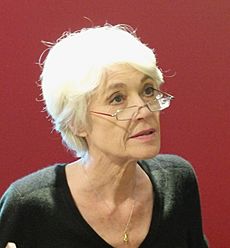
Besides writing about astrology, Françoise Hardy also wrote fiction and non-fiction books. Her autobiography, Le désespoir des singes... et autres bagatelles, was released on October 9, 2008. It became a bestseller in France, selling 250,000 copies.
In 2012, Françoise published her first novel, L'amour fou. It was released at the same time as a music album with the same title. Françoise had been working on the story, which is about an obsessive romantic relationship, for 30 years. She had put the text aside and didn't plan to release it. However, her editor and friend encouraged her to do so. Françoise felt it was a good idea to publish the book to mark her 50 years in music. She said it was "the story that has been the matrix of almost all of my lyrics from the start."
After her albums La pluie sans parapluie and L'Amour fou didn't sell well, Françoise decided to take a break from music and focus on writing. This led to her essay Avis non autorisés, released in 2015. In this book, she talks about the difficulties of getting older. She also shares her views on current events. Avis non autorisés was a commercial success. A year later, she published Un cadeau du ciel, a book where she reflects on her hospitalization in March 2015 for cancer, when she almost died. In the early 2020s, because she could no longer sing, Françoise worked on the song book Chansons sur toi et nous. Published in 2021, it collects all her song lyrics and includes her comments on them.
Musical Style and Development
Françoise Hardy's music covered many different genres. However, she always had a unique sound. This sound was known for her soft, airy voice and her love for sad songs. She was called the "queen of melancholy" because she often sang about sadness. She said in 2012, "In music, I like above all the slow, sad melodies, that stir the knife in the wound."
Writers have compared her music to that of English singer Marianne Faithfull. Her calm, distant way of singing has also been compared to German singer Nico. Her songs often talked about sadness, personal pain, heartache, one-sided love, sleeplessness, boredom, loneliness, and feeling trapped.
Françoise Hardy was known for being very particular about her music. For example, she chose to leave French studios to record in London in the mid-1960s. This made her different from other French artists. As she grew older, she became better at writing her own sad songs. She also carefully chose songs from other talented writers. She was also known for not thinking highly of her own singing and musical skills. She told Rock & Folk in 2018, "I'm not a musician, that's it. By stopping to compose, I went towards ease, but also towards realism. I understood that even if I did learn things, I would never be able to do as well as real melodists. That's why I thought it was best to bring in musicians whose work touched me."
Early Music (1962–1967)
Most of Françoise Hardy's famous music was made in the 1960s. She told The Independent in 1996, "Most people don't really know me artistically. The proof is always having to talk about the Sixties and the Beatles." Her first musical tastes were French chanson singers like Charles Trenet. She said Trenet "touches [her] more than the others because his music is sad and light." She was also a big fan of singer and songwriter Barbara, who inspired her to write her own songs.
In the early 1960s, she discovered English-language rock and roll and pop music through Radio Luxembourg. She was inspired by artists like Brenda Lee, the Everly Brothers, and especially Elvis Presley. Françoise felt "completely spellbound" by these foreign artists. She started singing and playing the guitar to try to be like them. She remembered in 2008, "I immediately identified with them, because they expressed teenage loneliness and awkwardness over melodies that were much more inspiring than their texts."
Even though she is seen as one of the best artists of the yé-yé pop style of the early-to-mid 1960s, she was different from others because she wrote much of her own music. She also stood out by avoiding the easy path of happy, "good girl" pop. According to Jean-Marie Périer, "She was the opposite of all the French new artists trying to look and sound American. And her melodies were sad, she didn't try to make them dance the twist." Besides her own songs, much of her 1960s music included versions of foreign songs from many styles, like American girl-groups, early rockabilly, and folk music.
Her first full album, Tous les garçons et les filles, had a rockabilly feel. It was the closest she got to the yé-yé genre. It was known for its simple sound, with just acoustic and electric guitar, bass, and jazz-influenced drums. Robert Ham of Paste felt that the album "reveals a musician that had yet to fully absorb her influences and make them her own." Russell Warfield of Drowned in Sound felt that "her first record sticks out like a sore thumb" and described it as "the product of a patriarchal music industry," meaning the music industry controlled her early work.
Her second album, Le premier bonheur du jour, showed artistic growth. It had more complex instruments and lyrics, including electric organs and "weeping" string arrangements. It included songs inspired by jazz and American girl groups. Despite their lasting popularity, Françoise was very critical of her first releases. She told Clash in 2018, "From very early on I felt very frustrated because I wanted to have beautiful electric guitars like those of the Shadows in the sixties... Instead, I had very bad French musicians and a terribly bad musical production. My albums began to improve when I went to London to record them. My first songs were not very interesting either."
Starting in the mid-1960s, her music became richer and fuller. She avoided the poor quality of French studios in 1964 and went to London to record with arranger Charles Blackwell. He helped her "reach new levels of sophistication." She told The Guardian in 2018, "I was happy from that moment. I was free to make another kind of music, not this mechanical music I had been trapped in." Françoise Hardy's music in the second half of the decade was influenced by the British Invasion pop. It also brought back the traditional French chanson style, which was romantic.
Her album Mon amie la rose, released that year, showed her music becoming more complex. It had stronger vocals and more experimental song structures. It was her most varied album yet, influenced by Phil Spector's Wall of Sound technique and Italian composer Ennio Morricone. Her music in 1965 and 1966 showed her style maturing. The sound moved from the thin sound of yé-yé pop to fuller rock arrangements. The overall sound of her next album, L'amitié, was much bigger. According to Pitchfork's Hazel Cills, "It wasn't until her fifth record La maison où j'ai grandi that Hardy grew into a more grown-up, baroque sound, one that matched the depth of her sorrow and its complexities." Similarly, Warfield thought it was the album where "she really settles into her sound." With Ma jeunesse fout le camp, her last 1960s album recorded in London, she "moved toward a more adult, calm form of orchestrated pop balladry." It has been called "her farewell to the yé-yé years."
Later Music (1968–2018)
Her return to French recording studios in 1968, Comment te dire adieu, was more MOR-oriented (a softer, easier-listening style) than her previous releases. Richie Unterberger felt its music was "perhaps even sadder and more sentimental than was the norm for Françoise." As the yé-yé era ended after the May 68 protests, Françoise "smartly reinvented herself as an elusive folk rock jazz chanteuse" with her early 1970s albums. She looked for a more mature and less pop-focused style to better show her true feelings.
The 1971 album La question is seen as a very important turning point in her career. It moved towards a less commercial sound with no obvious catchy parts. It is one of her "most sparsely produced efforts," with quiet, acoustic-flavored arrangements. Through the work of Brazilian guitarist Tuca, the album included strong influences of bossa nova music. Her vocals have been called "sultry" and "breathy." La question also marked the first time Françoise helped choose the string arrangements for her music.
After La question didn't sell well, Françoise Hardy moved towards a more folk and rock-influenced sound. Around this time, she admired the little-known English folk singer-songwriter Nick Drake and spoke highly of his work in interviews. She remembered, "For me, he didn't belong to a particularly British tradition... It is the soul which comes out of his songs that touched me deeply – romantic, poetic... but also the refined melodies." This led a producer to suggest that Nick Drake write an album of songs for her. Although Drake and Françoise met several times, the project was never completed. However, producer Tony Cox still wanted to work with Françoise. In late 1971, they recorded If You Listen, which featured British folk-rock musicians. Influenced by Drake, the album showed Françoise's taste for this musical style. It had "cinematic" arrangements that focused on acoustic guitar and light strings. The same year, she released Et si je m'en vais avant toi, also known as "the orange album." This album included influences from American blues, folk, and rock music. It had a slightly funny tone and catchier rhythms, which were unusual for the singer.
In 1972, Véronique Sanson's first album greatly impressed Françoise. She began to feel her own music was "very outdated." She described her impression of Sanson in her autobiography: "The originality and quality of the melodies, the lyrics, the production, and the singing made all other French singers, starting with me, seem like hasbeens." Françoise then hired Michel Berger, who produced Sanson's album, to oversee her 1973 album Message personnel. This album had arrangements by Michel Bernholc, who directed "a basic rock band backed by a lush set of strings [underlining] Hardy's wispy yet compelling vocals." The album is known for its sad, thoughtful mood and "classy, adult tone." The 1974 album Entr'acte was Françoise Hardy's first try at a concept album (an album where all the songs are connected by a story or theme). It featured orchestral arrangements by Del Newman.
A jazz-oriented pop album, 1977's Star was Françoise Hardy's first album arranged by Gabriel Yared. He would produce her music for the next 10 years. In 1978, as disco music was very popular, his team tried to make her sound fit the era with Musique saoûle. This album had a strong rhythm influenced by funk music. Françoise later said she felt uncomfortable singing over danceable rhythms. The 1988 album Décalages is known for its layered, atmospheric sound. It used a Synclavier synthesizer, even though Françoise wanted an acoustic album without trendy digital sounds.
Deeply inspired by alternative rock music, Françoise Hardy moved to a strong, guitar-focused modern rock style with Le danger. This was her first album in seven years. She was influenced by the English band Portishead and genres like grunge and Britpop. The album's harsh sound and lyrics showed the "very dark" time Françoise was going through in her personal life. The album Le danger did not sell well. This, among other reasons, caused Françoise to return to her usual soft and light style in her next album, Clair-obscur, released in 2000. Her last five albums are known for their elegant and sad sound. The 2006 album (Parenthèses...) is a collection of 12 duets. Compared to earlier albums, 2010's La pluie sans parapluie had a "sunnier" sound. Her 2012 album L'amour fou featured half-sung, half-spoken vocals and had a "resigned, philosophical" mood. The lyrics of her last album, Personne d'autre, released in 2018, talk about her old age and her own death. This was after she survived a major health crisis. Her voice on the album showed the effects of her illness. The dark topics in Personne d'autre are balanced by the singer's usual delicate and personal sound.
Legacy and Influence
Françoise Hardy was celebrated as a "French national treasure" and one of the greatest figures in French music ever. She was one of the best-selling music artists in French history, with over 7.6 million records sold by November 2017. American critic Richie Unterberger called her "indisputably the finest pop-rock artist to emerge from that country in the 1960s." He also said she should be in the Rock and Roll Hall of Fame. In 2011, an entry about Françoise Hardy was included in Le Petit Larousse Illustré, a famous French dictionary.
Long after her most famous time in the 1960s, Françoise Hardy is still seen as an important and inspiring person in fashion history. Designer Nicolas Ghesquière described her as "the very essence of French style." Her famous photos wearing a Paco Rabanne metal dress inspired the costume design for the film Priscilla, Queen of the Desert. Françoise Hardy was also an inspiration for Japanese designer Rei Kawakubo, who named her label Comme des Garçons after a line in the song "Tous les garçons et les filles."
Throughout her career, Françoise Hardy gained many fans among gay men and was seen as a gay icon. She often said that "her most devoted friends and fans are gay."
Françoise Hardy's musical influence can be found in the work of French-speaking artists like Coralie Clément and Carla Bruni. Writers have also pointed to her influence on the English avant-pop group Stereolab. Outside of France, she has inspired female singer-songwriters like Caroline Polachek and Cat Power. She has also influenced several alternative music acts. In 2021, Rivers Cuomo of the American rock band Weezer said Françoise Hardy was one of his "sonic ideals." Greg Gonzalez of the American dream pop band Cigarettes After ... called Françoise Hardy one of his biggest musical influences.
The 1971 album La question appeared on The Guardian's list of "1000 albums to hear before you die." In 2017, Pitchfork ranked Tous les garçons et les filles 90th on its list of "The 200 Best Albums of the 1960s." In 2023, Rolling Stone ranked Françoise Hardy at number 162 on its list of the 200 Greatest Singers of All Time.
Personal Life
Family
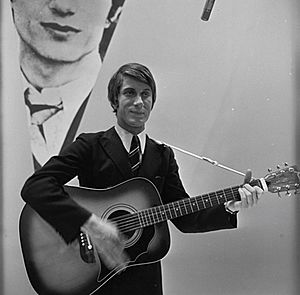
In mid-1962, Françoise Hardy met Salut Les Copains photographer Jean-Marie Périer. They started a romantic and professional relationship. They never lived together and were often apart because of their work, which made the relationship difficult. They broke up in 1966 but remained close friends and continued to work together.
Françoise Hardy began her well-known relationship with fellow singer Jacques Dutronc in 1967. They had a somewhat distant relationship and did not live together until after their only child, son Thomas, was born on June 16, 1973. In the autumn of 1974, Françoise and Dutronc moved into a house together in Paris. Every summer, the family went to a house Dutronc owned in Corsica. As an adult, Thomas Dutronc also became a musician.
Françoise Hardy and Jacques Dutronc got married on March 30, 1981, in a private ceremony. Françoise said they got married for "fiscal reasons" (money reasons). She explained that she had a health problem and was very worried. She was told it would be better for them to be married if something happened to her. She said, "I have always considered marriage as an uninteresting formality." They had a difficult relationship and separated in late 1988. They never divorced, and their relationship became a "special friendship." In 2016, Françoise told Le Parisien that even though Dutronc had a new partner, he did not want to divorce.
Françoise Hardy also talked about her family history, including her father and younger sister. In the early 1980s, she learned that her father lived a secret life. He died in the hospital on February 6, 1981, after being hurt. Françoise's sister had mental health struggles. In late May 2004, she was found dead at her home.
Health and Death
Between late 2004 and early 2005, Françoise Hardy was diagnosed with a type of cancer called MALT lymphoma. This began a very difficult time in her life. She had chemotherapy treatment, which worked at first. In March 2015, Françoise's health got worse. She had to go to the hospital, where she was put into a special sleep and almost died. During her time in the hospital, she also broke her hip and elbow. That month, she told Le Figaro: "I am very isolated, very handicapped by illness. I was diagnosed with lymphoma over ten years ago. But it is especially in the last three years that my symptoms have worsened. I also have a lot of difficulty walking. (...) There are times when I absolutely cannot see anyone and I cannot go out. But I remain positive, I live from day to day, I have no choice, I avoid thinking about it, it does not obsess me." She then had more chemotherapy and other treatments.
Françoise Hardy died of laryngeal cancer in Paris on June 11, 2024, at the age of 80. Before her death, she had also experienced several falls and bone fractures.
Selected Discography
- Untitled album (Tous les garçons et les filles) (1962)
- Untitled album (Le premier bonheur du jour) (1963)
- Untitled album (Françoise Hardy canta per voi in italiano) (1963)
- Untitled album (Mon amie la rose) (1964)
- Untitled album (L'Amitié) (1965)
- In English (1966)
- Untitled album (La maison où j'ai grandi) (1966)
- Ma jeunesse fout le camp... (1967)
- Untitled album (Comment te dire adieu) (1968)
- Untitled album (La question) (1971)
- Personne d'autre (2018)
Filmography
| Year | Title | Role | Director | Notes | Ref. |
|---|---|---|---|---|---|
| 1963 | Château en Suède | Ophélie | Roger Vadim | — | |
| 1964 | I ragazzi dell'Hully Gully | Herself | Marcello Giannini and Carlo Infascelli | musical performer | |
| 1965 | Questo pazzo, pazzo mondo della canzone | Bruno Corbucci and Giovanni Grimaldi | |||
| What's New Pussycat? | Judge's secretary | Clive Donner | small appearance | ||
| Altissima pressione | Herself | Enzo Trapani | musical performer | ||
| 1966 | Une balle au cœur | Anna | Jean-Daniel Pollet | — | |
| Masculin féminin | American officer's companion | Jean-Luc Godard | small appearance | ||
| Europa canta | Herself | José Luis Merino | musical performer | ||
| Grand Prix | Lisa | John Frankenheimer | — | ||
| 1968 | Monte Carlo: C'est La Rose | Herself | Michael Pfleghar | television special | |
| 1969 | L'homme qui venait du Cher | Suzanne | Pierre Desfons | television film | |
| 1972 | Les colombes | Young hippie | Jean-Claude Lord | small appearance | |
| 1976 | Si c'était à refaire | Herself | Claude Lelouch | musical performer |
Published Works
- Astrology Books
- Le grand livre de la Vierge (with Béatrice Guénin) (1979)
- Entre les lignes, entre les signes (with Anne-Marie Simond) (1986)
- L'astrologie universelle (1987)
- Les rythmes du zodiaque (2003)
- Non-fiction Books
- Notes secrètes: entretiens avec Eric Dumont (1991) (interview)
- Le désespoir des singes... et autres bagatelles (2008) (autobiography)
- Avis non autorisés... (2015) (essay)
- Un cadeau du ciel... (2016) (essay)
- Chansons sur toi et nous (2021) (songbook)
- Novels
- L'amour fou (2014)
Images for kids
-
Meeting Princess Margriet and sports executive Jaap van Praag.
-
Receiving the Edison Award in the "Youth" category from writer and TV personality Godfried Bomans.
-
Hardy arriving in Barcelona in 1963, greeted by Hispavox international director Luis Calvo.
-
Hardy presenting her first novel L'amour fou in Paris, November 2012.
-
Hardy and fellow musician Jacques Dutronc began their famous relationship in 1967 and got married in 1981.
See also
 In Spanish: Françoise Hardy para niños
In Spanish: Françoise Hardy para niños
- French fashion
- French rock music
- List of astrologers
- List of baroque pop artists
- List of folk rock artists
- List of French singers
- List of yé-yé singers


